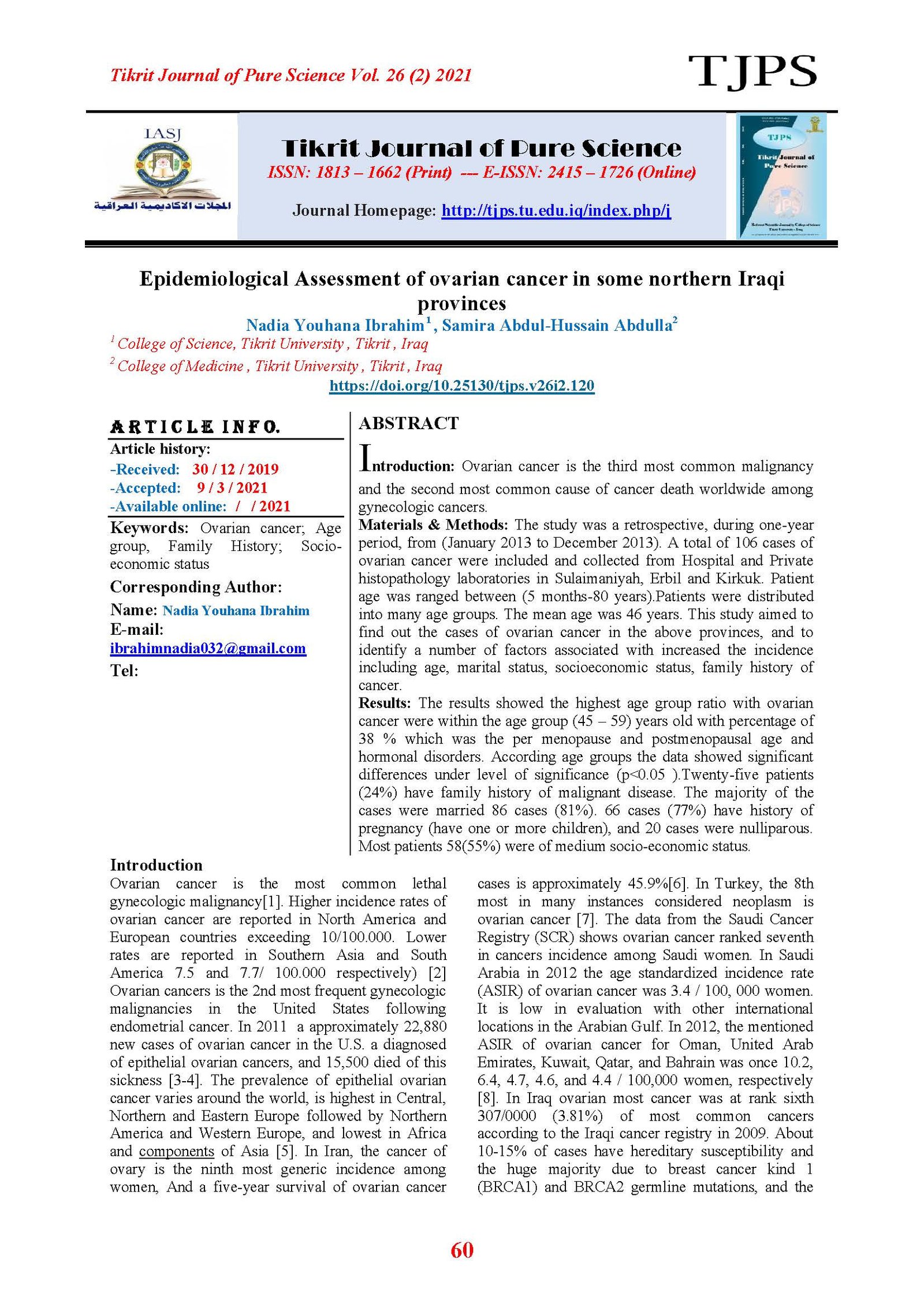Epidemiological Assessment of ovarian cancer in some northern Iraqi provinces
Main Article Content
Abstract
Introduction: Ovarian cancer is the third most common malignancy and the second most common cause of cancer death worldwide among gynecologic cancers.
Materials & Methods: The study was a retrospective, during one-year period, from (January 2013 to December 2013). A total of 106 cases of ovarian cancer were included and collected from Hospital and Private histopathology laboratories in Sulaimaniyah, Erbil and Kirkuk. Patient age was ranged between (5 months-80 years).Patients were distributed into many age groups. The mean age was 46 years. This study aimed to find out the cases of ovarian cancer in the above provinces, and to identify a number of factors associated with increased the incidence including age, marital status, socioeconomic status, family history of cancer.
Results: The results showed the highest age group ratio with ovarian cancer were within the age group (45 – 59) years old with percentage of 38 % which was the per menopause and postmenopausal age and hormonal disorders. According age groups the data showed significant differences under level of significance (p<0.05 ).Twenty-five patients (24%) have family history of malignant disease. The majority of the cases were married 86 cases (81%). 66 cases (77%) have history of pregnancy (have one or more children), and 20 cases were nulliparous. Most patients 58(55%) were of medium socio-economic status
Article Details

This work is licensed under a Creative Commons Attribution 4.0 International License.
Tikrit Journal of Pure Science is licensed under the Creative Commons Attribution 4.0 International License, which allows users to copy, create extracts, abstracts, and new works from the article, alter and revise the article, and make commercial use of the article (including reuse and/or resale of the article by commercial entities), provided the user gives appropriate credit (with a link to the formal publication through the relevant DOI), provides a link to the license, indicates if changes were made, and the licensor is not represented as endorsing the use made of the work. The authors hold the copyright for their published work on the Tikrit J. Pure Sci. website, while Tikrit J. Pure Sci. is responsible for appreciate citation of their work, which is released under CC-BY-4.0, enabling the unrestricted use, distribution, and reproduction of an article in any medium, provided that the original work is properly cited.
References
[1] Zhang, Y., Luo, G., Li, M. et al((2019). Global patterns and trends in ovarian cancer incidence: age, period and birth cohort analysis. BMC Cancer 19, 984.
[2] Parkin, D. M., Bray, F., Ferlay, J and Pisani, P (2005). Global cancer statistics, 2002. CA Cancer J Clin;55 (2):74-108.
[3] Halperin, E. C., Brady. L. W., Perez. C. A and Wazer, D. E (2013). Perez & Brady's Principles and Practice of Radiation Oncology. Lippincott Williams & Wilkins. PP:1454-57.
[4] Siegel, R., Naishadham, D and Jemal, A (2012). Cancer statistics for Hispanics/Latinos. CA Cancer J Clin, 62 (5):283-98.
[5] Lowe, K. A., Chia, V. M., Taylor, A., O'Malley, C., Kelsh, M., Mohamed, M., Mowat, F. S and Goff, B (2013). An International Assessment of Ovarian Cancer Incidence and Mortality. GynecolOncol, 130 (1):107-14
[6] Arab, M and Noghabaei, G (2013). Ovarian Cancer Incidence in Iran and the World. Reports of Radiotherapy and Oncology, 1 (2):69-72.
[7] Demirci, E., Daloglu, F.T., Calik, M., Altun, E, Sipa, S, and Borekci, B (2015) Changing Trends in the Incidence of Ovarian Neoplasia and Its Relationship with the Risk Factors: A Report of 311 Cases from North-Eastern Anatolia Region. North-Eastern Anatolia Region. Eurasian J Med. 2015 Feb;47(1):48-55
[8] Alghamdi, I. G., Hussain, I. I., Alghamdi, M. S., Alghamdi,, M. M., Dohal, A. A and El-Sheemy,,, M. A (2014). Incidence rate of ovarian cancer cases in Saudi Arabia: an observational descriptive epidemiological analysis of data from Saudi Cancer Registry 2001–2008). I J W H.,6: 639–45.
[9] Malander, S., (2004). One in 10 ovarian cancer patients carry germ line BRCA1 or BRCA2 mutations: results of a prospective study in Southern Sweden. Eur J Cancer, 40 (3): p. 422-8.
[10] Momenimovahed, Z., Tiznobaik, A., Taheri, S., & Salehiniya, H. (2019). Ovarian cancer in the world: epidemiology and risk factors. International journal of women's health, 11, 287–299.
[11] Mclemore, M. R., Miaskowski, Ch., Aouizerat, B. E., Chen, LM and Dodd, M. J (2009). Epidemiologic and Genetic Factors Associated with Ovarian Cancer. Cancer Nurs. 32 (4): 281–90.
[12] Arab, M., Khayamzadeh, M., Tehranian, A., Tabatabaeefar, M., Hosseini, M., Anbiaee, R., Golfam, F., and Akbari, M. E (2010) Incidence rate of ovarian cancer in Iran in comparison with developed countries. Ind. J. Can., 47 (3) : 322-27.
[13] Malik, J. A (2002). A prospective study of clinicopathological features of epithelial ovarian cancer in Pakistan. J Pak Med Assoc, 52 (4): 155-58
[14] Abdul Majeed, Abdul-M and Yahya, T. T (2008) Pathological study of ovarian tumors in Mosul. Tik.Med. J ; 14 (1):157-160.
[15] Merritt, M. A., De Pari, M., Vitonis, A. F., Titus, L. J., Crame, D. W., and Terry, K. L (2013) Reproductive characteristics in relationto ovarian cancer risk by histologicpathways. Human Reproduction, 28 (5) Pp: 1406–17.
[16] Hegazi, R. A., Abdel Wahab, K., El Nahas, W., Mosbah, M., Refky, B and Mohamed A Hegazy, M (2013). Epidemiological and Pathological Correlates of Postoperative Mortality of Patients with Ovarian Cancer. Surgery Curr Res, 3 (1):2-5
[17] Torre, L. A., Trabert, B., DeSantis, C. E., Miller, K. D., Samimi, G., Runowicz, C. D., Gaudet, M. M., Jemal, A., & Siegel, R. L. (2018). Ovarian cancer statistics. CA: a cancer journal for clinicians, 68(4), 284–296.
[18] Kurian, A. W., Baliseb, R. R., Valerie McGuireb. V and Whittemore, A. S (2005) Histologic types of epithelial ovarian cancer: have they different risk factors? Gynecologic Oncology, 96 : 520–30.
[19] Samra, Z. Q., Hussain, T., Khaliq, Z., ul-Haq, I and Anwar, r (2014). Ovarian Cancer among Women of Lahore Metropolitan; a Survey. IJIMS, 1 (6): 276-78.
